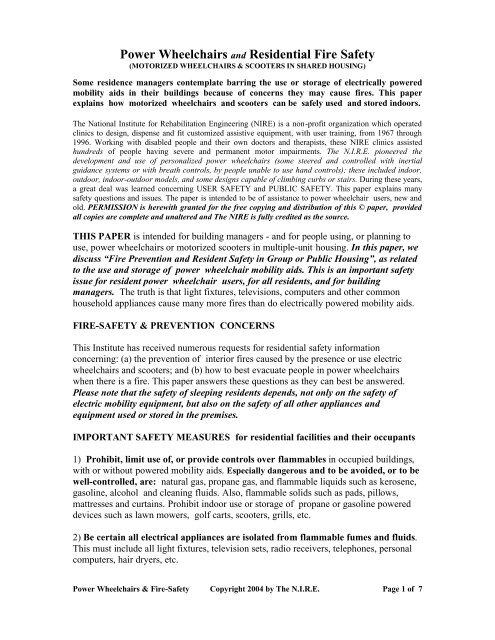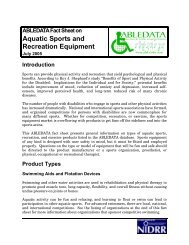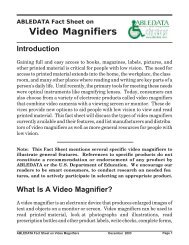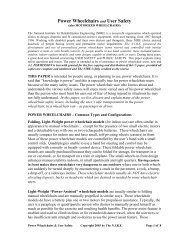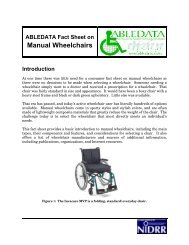Power Wheelchairs and Residential Fire Safety - AbleData
Power Wheelchairs and Residential Fire Safety - AbleData
Power Wheelchairs and Residential Fire Safety - AbleData
You also want an ePaper? Increase the reach of your titles
YUMPU automatically turns print PDFs into web optimized ePapers that Google loves.
<strong>Power</strong> <strong>Wheelchairs</strong> <strong>and</strong> <strong>Residential</strong> <strong>Fire</strong> <strong>Safety</strong><br />
(MOTORIZED WHEELCHAIRS & SCOOTERS IN SHARED HOUSING)<br />
Some residence managers contemplate barring the use or storage of electrically powered<br />
mobility aids in their buildings because of concerns they may cause fires. This paper<br />
explains how motorized wheelchairs <strong>and</strong> scooters can be safely used <strong>and</strong> stored indoors.<br />
The National Institute for Rehabilitation Engineering (NIRE) is a non-profit organization which operated<br />
clinics to design, dispense <strong>and</strong> fit customized assistive equipment, with user training, from 1967 through<br />
1996. Working with disabled people <strong>and</strong> their own doctors <strong>and</strong> therapists, these NIRE clinics assisted<br />
hundreds of people having severe <strong>and</strong> permanent motor impairments. The N.I.R.E. pioneered the<br />
development <strong>and</strong> use of personalized power wheelchairs (some steered <strong>and</strong> controlled with inertial<br />
guidance systems or with breath controls, by people unable to use h<strong>and</strong> controls); these included indoor,<br />
outdoor, indoor-outdoor models, <strong>and</strong> some designs capable of climbing curbs or stairs. During these years,<br />
a great deal was learned concerning USER SAFETY <strong>and</strong> PUBLIC SAFETY. This paper explains many<br />
safety questions <strong>and</strong> issues. The paper is intended to be of assistance to power wheelchair users, new <strong>and</strong><br />
old. PERMISSION is herewith granted for the free copying <strong>and</strong> distribution of this © paper, provided<br />
all copies are complete <strong>and</strong> unaltered <strong>and</strong> The NIRE is fully credited as the source.<br />
THIS PAPER is intended for building managers - <strong>and</strong> for people using, or planning to<br />
use, power wheelchairs or motorized scooters in multiple-unit housing. In this paper, we<br />
discuss “<strong>Fire</strong> Prevention <strong>and</strong> Resident <strong>Safety</strong> in Group or Public Housing”, as related<br />
to the use <strong>and</strong> storage of power wheelchair mobility aids. This is an important safety<br />
issue for resident power wheelchair users, for all residents, <strong>and</strong> for building<br />
managers. The truth is that light fixtures, televisions, computers <strong>and</strong> other common<br />
household appliances cause many more fires than do electrically powered mobility aids.<br />
FIRE-SAFETY & PREVENTION CONCERNS<br />
This Institute has received numerous requests for residential safety information<br />
concerning: (a) the prevention of interior fires caused by the presence or use electric<br />
wheelchairs <strong>and</strong> scooters; <strong>and</strong> (b) how to best evacuate people in power wheelchairs<br />
when there is a fire. This paper answers these questions as they can best be answered.<br />
Please note that the safety of sleeping residents depends, not only on the safety of<br />
electric mobility equipment, but also on the safety of all other appliances <strong>and</strong><br />
equipment used or stored in the premises.<br />
IMPORTANT SAFETY MEASURES for residential facilities <strong>and</strong> their occupants<br />
1) Prohibit, limit use of, or provide controls over flammables in occupied buildings,<br />
with or without powered mobility aids. Especially dangerous <strong>and</strong> to be avoided, or to be<br />
well-controlled, are: natural gas, propane gas, <strong>and</strong> flammable liquids such as kerosene,<br />
gasoline, alcohol <strong>and</strong> cleaning fluids. Also, flammable solids such as pads, pillows,<br />
mattresses <strong>and</strong> curtains. Prohibit indoor use or storage of propane or gasoline powered<br />
devices such as lawn mowers, golf carts, scooters, grills, etc.<br />
2) Be certain all electrical appliances are isolated from flammable fumes <strong>and</strong> fluids.<br />
This must include all light fixtures, television sets, radio receivers, telephones, personal<br />
computers, hair dryers, etc.<br />
<strong>Power</strong> <strong>Wheelchairs</strong> & <strong>Fire</strong>-<strong>Safety</strong> Copyright 2004 by The N.I.R.E. Page 1 of 7
3) <strong>Power</strong> wheelchairs <strong>and</strong> scooters can be limited to the safer types. They should be<br />
electrically powered <strong>and</strong> have these characteristics, for maximum safety:<br />
(a) Use sealed gel type rechargeable batteries. (NO liquid electrolyte).<br />
(b) Use no-spark electronically controlled battery charger with safety cables & plugs.<br />
(c) Use wheelchair motors that are ac brushless induction motors. Avoid all brush-type<br />
motors, whether ac or dc powered, because the brushes spark.<br />
(d) The wheelchair controller should NOT have ON-OFF switches (which spark) unless<br />
they are sealed <strong>and</strong> fireproof. It should have continuously variable electronic speed &<br />
power controls.<br />
(e) Every wheelchair <strong>and</strong> scooter in a building should have fire-retardant cushions <strong>and</strong><br />
upholstery. Likewise, all beds, sofas, upholstered furniture, cushion, pillows, carpets,<br />
<strong>and</strong> curtains should be of fire-retardant material.<br />
(f) Residents <strong>and</strong> visitors should be forbidden to smoke in the buildings.<br />
(g) All areas should be equipped with approved fire- <strong>and</strong> smoke- detectors. They should<br />
also have natural gas <strong>and</strong> carbon monoxide detectors. All areas should have audible fire<br />
alarm warning systems <strong>and</strong>, if deaf people are resident, visual <strong>and</strong> vibratory alarm signals<br />
for the deaf people.<br />
(h) All rooms, apartments, offices, closets, storage areas, waste storage, utility, <strong>and</strong><br />
laundry areas should be subjected to regularly scheduled (<strong>and</strong> to occasional surprise)<br />
safety inspections, by qualified inspectors.<br />
(i) Oxygen Users may have in their living quarters, either of two types of breathing<br />
aids. (1) One type, often used by (normally mobile) people with COPD or other<br />
breathing disorders, is a room-air oxygen concentration machine. An apartment with<br />
such a machine is at increased risk for fire. The apartment should NOT have a gas heater<br />
or a gas stove because the atmosphere is much more explosive with the concentrator than<br />
without. Also, cigarettes <strong>and</strong> open flames should be avoided in such an apartment.<br />
(2) The other type oxygen device involves use of a thin plastic tube in a person’s nose,<br />
to deliver the needed oxygen. This nasal tube does NOT normally release oxygen into the<br />
apartment <strong>and</strong> should be completely safe for everyone.<br />
(j) <strong>Power</strong>ed Ventilators - or Respirators – may, when needed for life support, be in<br />
the bedroom <strong>and</strong> possibly on a powered wheelchair. In the residence, they are usually<br />
plugged into an outlet <strong>and</strong> ac-powered. On a wheelchair, they are battery powered. These<br />
are life-support devices that must be kept running <strong>and</strong> must be kept with the user, no<br />
matter what the emergency. Housing management <strong>and</strong> maintenance personnel should be<br />
aware of all residents using these devices; should have approved power backup<br />
arrangements; should evacuate these disabled people first; <strong>and</strong> should arrange for<br />
ambulances or EMT personnel to remove these residents <strong>and</strong> their ventilators quickly <strong>and</strong><br />
<strong>Power</strong> <strong>Wheelchairs</strong> & <strong>Fire</strong>-<strong>Safety</strong> Copyright 2004 by The N.I.R.E. Page 2 of 7
efficiently when there is an evacuation. Note: Most of these devices will not start fires<br />
because they are designed to be used in oxygen enriched atmospheres.<br />
EVACUATION METHODS for power wheelchair users (if elevators not working)<br />
1) Six steps or fewer: It may be possible for one or two strong men to manually roll an<br />
occupied power wheelchair down the steps. This may be safest with one strong man on<br />
top, <strong>and</strong> one below.<br />
2) More than six steps, but fewer than 15: The disabled person may be taken down<br />
either in a lightweight manual wheelchair or on a stretcher. The power wheelchair may<br />
then be manually carried down, unoccupied.<br />
3) 16 steps or more: Leave the power wheelchair – <strong>and</strong> carry the disabled person down<br />
the stairs on a stretcher or in a light-weight manual wheelchair.<br />
4) Assuming elevators are inoperative, the facilities should have outside ramp escape<br />
routes that interface with 1st, 2nd <strong>and</strong> 3rd floor emergency exits. NOTE: This may be<br />
easier to implement for buildings on hilly terrain (than for buildings on flat, level terrain.)<br />
ENSURING FIRE-SAFE ELECTRICALLY POWERED MOBILITY AIDS<br />
( <strong>Power</strong>ed <strong>Wheelchairs</strong> <strong>and</strong> Scooters ... <strong>and</strong> their Battery Chargers)<br />
Equipment dealers <strong>and</strong> manufacturers who sell these types of mobility devices<br />
know which models are safest with regard to residential fire potentials, primary <strong>and</strong><br />
secondary. These manufacturers <strong>and</strong> vendors know or should know about motors with<br />
<strong>and</strong> without brushes <strong>and</strong> non-sparking variable power & speed controls.<br />
It is wise for all buyers of electric mobility aids to choose models that, first, are of<br />
the safest design <strong>and</strong> construction. From these models, they can then select specific<br />
configurations compatible with their physical <strong>and</strong> functional needs. These priorities are<br />
wise, even for a person living in his own single-family home. As for group living,<br />
whether in apartment buildings or in assisted living facilities, the electrically powered<br />
mobility aids must be fire-safe for the well-being of all residents of <strong>and</strong> visitors to the<br />
building. Thus, the building’s management can <strong>and</strong> should be actively involved in<br />
establishing <strong>and</strong> maintaining the best possible fire prevention conditions. Because this<br />
goes well beyond the wheelchairs <strong>and</strong> scooters (as discussed in this paper), the services<br />
of an architect or safety engineer may be very helpful for planning <strong>and</strong> for periodic safety<br />
inspections.<br />
For wheelchair users, every building should have emergency evacuation<br />
plans <strong>and</strong> there should be periodic evacuation tests or training drills. These will<br />
ensure preparedness for when a real emergency occurs.<br />
Stair-Climbing <strong>Wheelchairs</strong> exist but are rarely used. If a disabled resident<br />
happens to own <strong>and</strong> use a stair-climbing wheelchair, then special precautions must be<br />
taken during an emergency evacuation – if it is to be used at all. It is preferable to NOT<br />
<strong>Power</strong> <strong>Wheelchairs</strong> & <strong>Fire</strong>-<strong>Safety</strong> Copyright 2004 by The N.I.R.E. Page 3 of 7
use it because of the stress conditions, haste, <strong>and</strong> the presence of so many other people. If<br />
it is to be used to descend stairs, then it should be used for one flight of stairs – or less.<br />
Never for more. Even then, it should be used only by an experienced user; only with<br />
other people kept away for their own safety (should it fall); <strong>and</strong> only after the steps are<br />
visually inspected <strong>and</strong> found to be free of debris. Of course, if visibility (of the steps) is<br />
poor due to power failure, smoke or other factors, use of a stair-climbing/descending<br />
wheelchair should not even be considered.<br />
SOME USEFUL ADDITIONAL INFORMATION – for wheelchair user<br />
evacuations - with or without powered mobility-device removals:<br />
A BASIC DANGER OF STAIR-CLIMBING or DESCENT in a wheelchair is the fact that,<br />
if an occupied stair-climbing wheelchair falls down a flight of stairs (it could fall from near<br />
the top of a 32-step stairway) then serious injury or death to the user is the likely. Others in<br />
the area may also be injured or killed by such a fall.<br />
Age & Health Factors can be very significant to safety, both in preventing – <strong>and</strong> in<br />
surviving accidents. Examples: (1) A young paraplegic with normal upper body<br />
functions <strong>and</strong> strength. This fast moving person, with good eyesight, may well maneuver<br />
fast <strong>and</strong> vigorously enough to prevent an accident. Even if his wheelchair turns over or<br />
falls down a flight of stairs, the person has the highest chance of surviving with minimal<br />
injuries. Or, (2) an elderly paraplegic, or a wheelchair user of any age with upper body<br />
weakness <strong>and</strong> impaired movement abilities, is less likely to prevent an accident or fall at<br />
the last moment <strong>and</strong> is much more likely to suffer serious injuries or death in a fall,<br />
collision or accident.<br />
USERS of <strong>Power</strong> <strong>Wheelchairs</strong> – DISABILITY CATEGORIES & SAFETY RISKS<br />
as summarized below, do not include the added hazards of navigating a power wheelchair<br />
with poor vision or with susceptibility to fainting or unexpected seizures. It is assumed<br />
that all wheelchair users are strapped in for safety. Two straps should be used: one, down,<br />
lap to chair – <strong>and</strong> the other higher up, securing the upper body to the backrest of the<br />
wheelchair. The wheelchair user must be secured both ways for maximum safety.<br />
A) Paraplegics - Healthy, Fit & Active are typically the safest users of manual,<br />
power-assisted, <strong>and</strong> fully powered wheelchairs. LOWEST RISK<br />
B) Amputees – Missing Legs <strong>and</strong>/or Arms but with active upper bodies are usually<br />
safe users of power wheelchairs, depending on the type of control devices used.<br />
If planned <strong>and</strong> implemented properly, then LOW RISK.<br />
C) People with Weak or Poorly Controlled Upper Bodies using st<strong>and</strong>ard joystick<br />
to reliably control power wheelchairs. This category may include some people<br />
with Cerebral Palsy, some with Multiple Sclerosis, some with Parkinson Disease,<br />
<strong>and</strong> people with many other conditions. Some of these conditions may cause<br />
impaired eyesight, slowed reflexes <strong>and</strong>/or impaired judgment. All should be fully<br />
screened for such functional deficits just as for automobile driving safety.<br />
MODERATE RISK.<br />
<strong>Power</strong> <strong>Wheelchairs</strong> & <strong>Fire</strong>-<strong>Safety</strong> Copyright 2004 by The N.I.R.E. Page 4 of 7
D) People with Little or No Upper Body Movement, using special quad controls<br />
such as mouth joystick, puff & sip breath control, or gyroscopic (inertial)<br />
wheelchair controls. HIGH RISK.<br />
E) Paralyzed Small People – Children <strong>and</strong> “very small” Adults ...in special seats<br />
or carriers often need a power wheelchair, most of all when significantly<br />
paralyzed. Depending on mechanical implementations, individual conditions, <strong>and</strong><br />
personalized mobility <strong>and</strong> safety training, these people are at HIGH RISK.<br />
SAFETY - INFORMATION ... re Use of <strong>Power</strong> <strong>Wheelchairs</strong> (by users or rescuers)<br />
1) Mechanical BRAKES that can be set or released by the wheelchair user<br />
are necessary safety items – an absolute “must” for outdoor wheelchair<br />
use. Some chairs have mechanical brakes that are h<strong>and</strong>-operated by a user<br />
with normal functioning of both h<strong>and</strong>s - but not by users with impaired<br />
h<strong>and</strong>s. Other chairs have no mechanical brakes but use “dynamic<br />
braking.” This helps slow the chair to a rapid stop when powered <strong>and</strong><br />
moving. It does NOT lock the wheels to prevent rolling down a steep incline.<br />
Buyers of power wheelchairs should always insist that the vendor includes<br />
mechanical brakes that the user can operate. They must be operable when<br />
moving, to brake, stop <strong>and</strong> lock the chair. Also, it must be possible for the<br />
wheelchair user to manually lock or to release the mechanical brakes ...<br />
when stopped. For quadriplegics unable to move a lever, it is feasible to<br />
use st<strong>and</strong>ard mechanical brakes that are set, locked <strong>and</strong> unlocked by small<br />
user-controllable electric motors.<br />
2) FRONT-WHEEL Configurations are very important for user safety.<br />
<strong>Power</strong> wheelchairs for outdoor use should always have powered large<br />
wheels in front; never free-swinging casters. Indoor wheelchairs with front<br />
casters are safe for outdoor use only on flat, level surfaces. They are at<br />
risk on sidewalks because of slab variations <strong>and</strong> irregularities, <strong>and</strong> totally<br />
unsafe on grass <strong>and</strong> soil. <strong>Wheelchairs</strong> with front casters are designed for<br />
indoor use because they offer better indoor maneuverability.<br />
3) USER ARM-STABILIZATION should be considered for the wheelchair<br />
user with impaired arm <strong>and</strong> h<strong>and</strong> function. An orthotic elbow or forearm<br />
support can be installed on the wheelchair to support the h<strong>and</strong> used to<br />
operate the wheelchair’s controls. This support can provide vital<br />
stabilization for the h<strong>and</strong> that steers <strong>and</strong> controls the power wheelchair.<br />
4) SAFETY SHUT-OFF & BRAKING CONTROLS should be provided<br />
for power wheelchair users who use mouth, breath, or other than h<strong>and</strong><br />
controls. The user with normal use of one h<strong>and</strong> can steer the power chairs<br />
with the control stick, can operate auxiliary power control switches <strong>and</strong><br />
can apply or release mechanical brakes. Quadriplegics should have special<br />
devices installed immediately to shut the power off <strong>and</strong> apply the brakes,<br />
if special sensors detect the wheelchair moving unsafely or out of control.<br />
The seller of the wheelchair <strong>and</strong> controls should include these safety<br />
<strong>Power</strong> <strong>Wheelchairs</strong> & <strong>Fire</strong>-<strong>Safety</strong> Copyright 2004 by The N.I.R.E. Page 5 of 7
features, which should be tested with the user <strong>and</strong> be approved by an<br />
occupational therapist..<br />
5) Traversing INCLINES – Always steer UP or DOWN an incline.<br />
NEVER travel across an incline ... because the wheelchair is likely to fall<br />
over sideways - if you do. For wheelchairs with casters in front, avoid<br />
areas in the pavement or path that tilt to one side to avoid having the<br />
wheelchair roll off the path <strong>and</strong> over an embankment.<br />
6) Avoiding GROUND OBSTACLES to Wheels ... such as stones, cracks,<br />
curbs, etc. which must be seen <strong>and</strong> avoided by the wheelchair user to<br />
prevent sudden deflection of the chair to one side, off the path.<br />
7) BATTERIES should be Fully Charged before leaving home. It is<br />
dangerous to be str<strong>and</strong>ed outdoors in a power wheelchair with dead<br />
batteries. Periodically, the batteries should be checked by a technician for<br />
physical condition, cable connections <strong>and</strong> remaining charge capacities.<br />
8) <strong>Power</strong> wheelchair Users often have a CELL PHONE ... for safety.<br />
People with impaired h<strong>and</strong> dexterity, unable to operate a st<strong>and</strong>ard cell<br />
phone, can have a cell phone attached to the wheelchair that is modified<br />
for use by even a quadriplegic. If you cannot afford monthly cell phone<br />
fees, then get a “911-only” cell phone for which there are no monthly<br />
charges. Cell phones should be wired to work from both internal battery<br />
<strong>and</strong> wheelchair battery. Electrical noise filters may be needed to suppress<br />
motor noise. Wiring should be “fire-safe”.<br />
9) <strong>Power</strong>ed VENTILATOR Users should have a separate rechargeable<br />
battery on the wheelchair, for the ventilator. This assures that the<br />
ventilator will not fail even if the power wheelchair battery is exhausted.<br />
There should be an audible alarm device <strong>and</strong> the chair should have a cell<br />
phone or a 911 phone.<br />
10) Avoid RAIN <strong>and</strong> SNOW which are especially hazardous to power<br />
wheelchair users, <strong>and</strong> to the expensive equipment. Try to stay out of<br />
falling rain or snow; try to stay off wet, slippery surfaces coated with rain<br />
or snow. If you must travel in rain or snow, use a wheelchair van.<br />
11) When being TRANSPORTED in a Wheelchair Van always make<br />
certain that: (a) the wheels of the wheelchair are locked to the floor of the<br />
van; (b) that the wheelchair undercarriage or seat is tightly strapped down<br />
to the floor. (c) that the user is strapped DOWN to the seat – <strong>and</strong> BACK ,<br />
from the chest to the seat’s back structure. Countless wheelchair users<br />
have been thrown forward, out of their chairs, into the windshield <strong>and</strong> to<br />
their deaths because they did not follow these precautions. These must<br />
apply whether the van is privately owned, rented or a public for-hire<br />
service vehicle.<br />
12) Outdoor STAIR-CLIMBING <strong>Wheelchairs</strong>. Outdoor steps are usually<br />
wider, deeper <strong>and</strong> shallower than inside steps, <strong>and</strong> often of shorter height.<br />
<strong>Power</strong> <strong>Wheelchairs</strong> & <strong>Fire</strong>-<strong>Safety</strong> Copyright 2004 by The N.I.R.E. Page 6 of 7
Some outdoor power wheelchairs with large, powered wheels in front,<br />
are designed to safely carry the user up or down flights of outdoor steps,<br />
as found in front of courthouses or public buildings. These chairs cannot<br />
safely carry a person up or down the types of stairs found indoors, in<br />
homes, offices <strong>and</strong> public buildings. Never try on indoor stairways!<br />
13) Indoor STAIR-CLIMBING <strong>Wheelchairs</strong> are the most dangerous to use<br />
because indoor steps are steep, narrow, high <strong>and</strong> have short depths as<br />
compared with outdoor steps. Most indoor stairways are not designed to<br />
support heavy weight in one area <strong>and</strong> can crack or break without warning.<br />
Also, indoor steps often have poor visibility so that unseen clutter, wet<br />
spots <strong>and</strong> damaged areas can cause the heavy power wheelchair to slip,<br />
slide, lose its grip on the stairs, <strong>and</strong> crash to the bottom injuring or killing<br />
the user. CAUTION: Always have an able-bodied wheelchair technician<br />
or mobility trainer who is familiar with the stair-climber, test climb <strong>and</strong><br />
descend a particular flight of indoor stairs before the wheelchair user tries<br />
it. Even then, the user should climb <strong>and</strong> then descend the same stairway<br />
two or three times in the presence of the technician or trainer. CAUTION:<br />
Stair-climbing wheelchairs may be unsafe in a private home because they<br />
are heavy. With batteries, such a wheelchair may weigh about 400 lbs.<br />
Add 200 lbs. for the user <strong>and</strong> the total weight can equal 600 lbs. This is<br />
enough weight to crack, break or dislodge one or more steps, causing the<br />
wheelchair <strong>and</strong> user to fall down the entire flight of stairs.<br />
14) Periodic Preventive MAINTENANCE is absolutely necessary to<br />
maintain the safety of any power wheelchair, stair-climbing or not. We<br />
recommend daily minor, <strong>and</strong> weekly major inspections by the user. We<br />
also recommend a professional inspection at least once every 3 months for<br />
most users, <strong>and</strong> as often as once a month for very active <strong>and</strong>/or severely<br />
disabled users. If tires are air-inflated, air pressure should be checked<br />
before each day’s use. Solid tires should be visually inspected for breaks.<br />
For SAFETY, legal <strong>and</strong> financial reasons, it is recommended that all<br />
power wheelchair service be provided by the seller, by the manufacturer<br />
or by a local mechanic who is designated as a “manufacturer’s<br />
representative”.<br />
For additional information or free technical support, please email: nire@warwick.net<br />
or contact us by regular mail or telephone.<br />
The National Institute for Rehabilitation Engineering<br />
Box 1088 – Hewitt, NJ 07421 U.S.A. Tel. (800) 736-2216<br />
Copyright 2004 by The National Institute for Rehabilitation Engineering<br />
(The N.I.R.E. is an IRS 501(c)3 organization helping people with disabilities)<br />
This paper may be freely copied <strong>and</strong> freely distributed provided all copies are complete <strong>and</strong> unaltered.<br />
<strong>Power</strong> <strong>Wheelchairs</strong> & <strong>Fire</strong>-<strong>Safety</strong> Copyright 2004 by The N.I.R.E. Page 7 of 7


